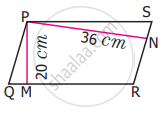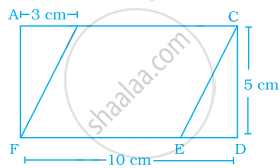Advertisements
Advertisements
प्रश्न
Find the missing values.
| Base | Height | Area |
| 18 cm | 5 cm |
उत्तर
Given: Base 6 = 18 cm
Height h = 5 cm
Area of the parallelogram = b × h sq.units
= 18 × 5 cm2
= 90 cm2
Tabulating the results, we get
| Base | Height | Area |
| 18 cm | 5 cm | 90 cm2 |
APPEARS IN
संबंधित प्रश्न
If base of a parallelogram is 18 cm and its height is 11 cm, find its area.
If area of a parallelogram is 29.6 sq cm and its base is 8 cm, find its height.
The two sides of the parallelogram ABCD are 6 cm and 4 cm. The height corresponding to the base CD is 3 cm.
Find the
(i) area of the parallelogram.
(ii) the height corresponding to the base AD.

What happens to the area of the parallelogram if the base is increased 2 times and the height is halved?
An agricultural field is in the form of a parallelogram, whose area is 68.75 sq.hm. The distance between the parallel sides is 6.25 cm. Find the length of the base
In a parallelogram PQRS (See the diagram) PM and PN are the heights corresponding to the sides QR and RS respectively. If the area of the parallelogram is 900 sq.cm and the length of PM and PN are 20 cm and 36 cm respectively, find the length of the sides QR and SR
If the base and height of a parallelogram are in the ratio 7 : 3 and the height is 45 cm, then fixed the area of the parallelogram
Find the height of the parallelogram whose base is four times the height and whose area is 576 sq.cm
If the sides of a parallelogram are increased to twice its original lengths, how much will the perimeter of the new parallelogram?
In the given figure, area of parallelogram BCEF is ________ cm2 where ACDF is a rectangle.

